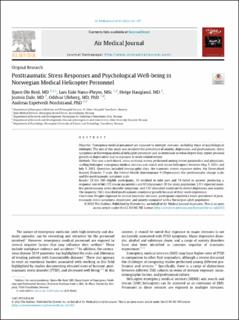Posttraumatic Stress Responses and Psychological Well-being in Norwegian Medical Helicopter Personnel
| dc.contributor.author | Reid, Bjørn Ole | |
| dc.contributor.author | Næss-Pleym, Lars E. | |
| dc.contributor.author | Haugland, Helge | |
| dc.contributor.author | Dale, Jostein | |
| dc.contributor.author | Uleberg, Oddvar | |
| dc.contributor.author | Nordstrand, Andreas Espetvedt | |
| dc.date.accessioned | 2023-03-22T08:37:37Z | |
| dc.date.available | 2023-03-22T08:37:37Z | |
| dc.date.created | 2022-03-21T11:08:50Z | |
| dc.date.issued | 2022 | |
| dc.identifier.citation | Air Medical Journal. 2022, 41 (3), 292-297. | en_US |
| dc.identifier.issn | 1067-991X | |
| dc.identifier.uri | https://hdl.handle.net/11250/3059687 | |
| dc.description.abstract | Objective Emergency medical personnel are exposed to multiple stressors, including those of psychological etiologies. The aim of this study was to report the prevalence of anxiety, depression, and posttraumatic stress symptoms in Norwegian medical helicopter personnel and to determine to what degree they report personal growth or deprecation due to exposure to work-related events. Methods This was a web-based, cross-sectional survey performed among rescue paramedics and physicians staffing helicopter emergency medical services and search and rescue helicopters between May 5, 2021, and July 5, 2021. Questions included demographic data, the traumatic events exposure index, the Generalized Anxiety Disorder 7 scale, the Patient Health Questionnaire 9 (Depression), the posttraumatic change scale, and the posttraumatic symptom scale. Results Of the 245 eligible participants, 10 declined to take part and 74 failed to answer, producing a response rate of 66% (72 rescue paramedics and 89 physicians). Of the study population, 3.9 % reported manifest posttraumatic stress disorder symptoms, and 1.9% described moderate to severe depression and anxiety. The majority (76%) described posttraumatic emotional growth because of their work experience. Conclusion Despite exposure to several traumatic stressors, participants reported a lower prevalence of posttraumatic stress symptoms, depression, and anxiety compared with a Norwegian adult population. Previous article in issue | en_US |
| dc.language.iso | eng | en_US |
| dc.publisher | Elsevier B. V. | en_US |
| dc.rights | Attribution-NonCommercial-NoDerivatives 4.0 Internasjonal | * |
| dc.rights.uri | http://creativecommons.org/licenses/by-nc-nd/4.0/deed.no | * |
| dc.title | Posttraumatic Stress Responses and Psychological Well-being in Norwegian Medical Helicopter Personnel | en_US |
| dc.title.alternative | Posttraumatic Stress Responses and Psychological Well-being in Norwegian Medical Helicopter Personnel | en_US |
| dc.type | Peer reviewed | en_US |
| dc.type | Journal article | en_US |
| dc.description.version | publishedVersion | en_US |
| dc.source.pagenumber | 292-297 | en_US |
| dc.source.volume | 41 | en_US |
| dc.source.journal | Air Medical Journal | en_US |
| dc.source.issue | 3 | en_US |
| dc.identifier.doi | 10.1016/j.amj.2022.02.006 | |
| dc.identifier.cristin | 2011315 | |
| cristin.ispublished | true | |
| cristin.fulltext | original | |
| cristin.qualitycode | 1 |
Tilhørende fil(er)
Denne innførselen finnes i følgende samling(er)
-
Institutt for psykologi [3030]
-
Publikasjoner fra CRIStin - NTNU [37737]
-
Publikasjoner fra Cristin - St. Olavs hospital [1503]
-
St. Olavs hospital [2483]

